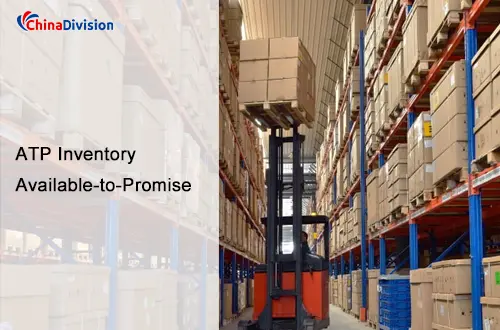Core Concepts and Calculation Methods of ATP Inventory
How can one balance inventory costs with the ability to deliver to customers in an uncertain market? Overstocking ties up capital, while stockouts lead to customer churn. Traditional inventory management methods are no longer adaptable to the dynamic international market. Consequently, ATP (Available-to-Promise) inventory management becomes a key tool to address this challenge.
Table of Contents
As a service provider deeply engaged in international warehousing, logistics, and transportation, Chinadivision will draw on its practical experience to provide an in-depth analysis of the core value and implementation strategies of ATP.
What is ATP Inventory?
ATP (Available-to-Promise) inventory, or "available-to-promise inventory," refers to the quantity of goods a company can promise to deliver to customers immediately or at a specific time in the future, based on current inventory, goods in transit, and production plans. This inventory, after deducting any allocated quantities, safety stock, and goods in transit, represents the quantity of products a company can realistically commit to delivering to new orders. Dynamically reflects a company's current "fulfillment capability" and is a core indicator for transparent supply chain management.

Its core value lies in:
Precise commitments: Avoid overselling or stockouts, enhancing customer trust;
Dynamic optimization: Real-time integration of supply chain data allows for flexible adjustment of allocation strategies;
Support for multi-channel sales: Flexible allocation of inventory between e-commerce platforms, wholesale channels, and self-operated online stores;
Controllable costs: Reduce the additional costs associated with emergency replenishment or excess inventory.
What does accurate ATP inventory management mean?
Avoid overselling or stockouts
Improve on-time order delivery rates
Optimize global inventory allocation
Enhance customer trust and satisfaction
ATP Inventory Calculation Method
ATP = Current Available Inventory + Inventory in Transit - Committed Orders - Safety Stock
However, in practice, more complex variables must be considered:
Supply Chain Nodes: These include factory production cycles, cross-border transportation times, and customs clearance efficiency;
Demand Fluctuations: Forecasting inventory consumption due to seasonal peaks and promotional activities;
Risk Buffers: Allowing for uncertainties such as exchange rate fluctuations and logistics delays. Chinadivision's Solution:
Using its independently developed WMS (Warehouse Management System) and TMS (Transportation Management System), we synchronize global warehouse data in real time, combine AI algorithms to predict demand fluctuations, and dynamically adjust ATP thresholds.
Q&A on User Pain Points and Practical ATP Practices
What is the fundamental difference between ATP and conventional inventory management?
Conventional inventory management focuses solely on "on-hand inventory quantity," while ATP is a dynamic commitment mechanism that considers time dimensions (e.g., "deliverable within 7 days") and supply chain collaboration (e.g., "factory production capacity next week").
How to resolve data silos in ATP calculations?
Many companies suffer from data delays and distorted ATP calculations due to system fragmentation. Chinadivision integrates data from multiple systems, including ERP, OMS, and WMS, through API integration, achieving end-to-end visibility.
How can Chinadivision improve your ATP management efficiency?
As a professional international warehousing, logistics, and transportation service provider, Chinadivision offers comprehensive ATP optimization solutions:
Intelligent Warehousing System
Our WMS system provides real-time ATP calculation and early warning capabilities, with an accuracy rate of up to 99.7%. Global Inventory Visibility Platform
We provide a unified inventory management system that monitors the ATP status of warehouses worldwide in real time.
Customized Logistics Solutions
Design optimal inventory distribution and replenishment strategies based on your product characteristics and sales models.
Distributed Warehousing Network
Strategically deployed overseas warehouses shorten delivery times and improve ATP reliability.
Data Analysis Services
Provide in-depth ATP-related analysis reports to help you optimize your inventory strategy.
Chinadivision has over 10 years of international logistics experience, serving over 2,000 B2B companies and e-commerce sellers. Our professional team and advanced systems can help you address various ATP management challenges and maximize supply chain efficiency.
ATP inventory is more than just a number; it represents a company's commitment to its customers. To stand out in the global market, ATP management capabilities are essential. In today's world of constant uncertainty, ATP inventory management is not just a technical tool; it is a reflection of a company's supply chain resilience. Chinadivision is committed to working with you, using data as the sail and efficiency as the rudder, to jointly navigate the blue ocean of global commerce.





